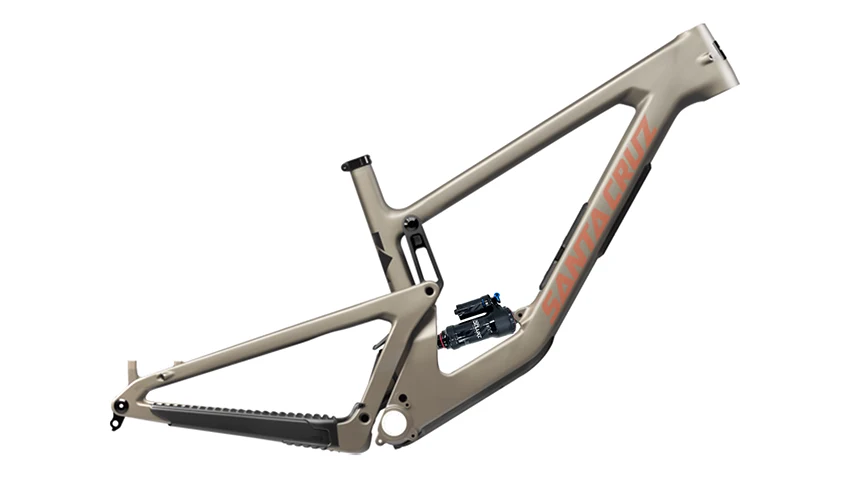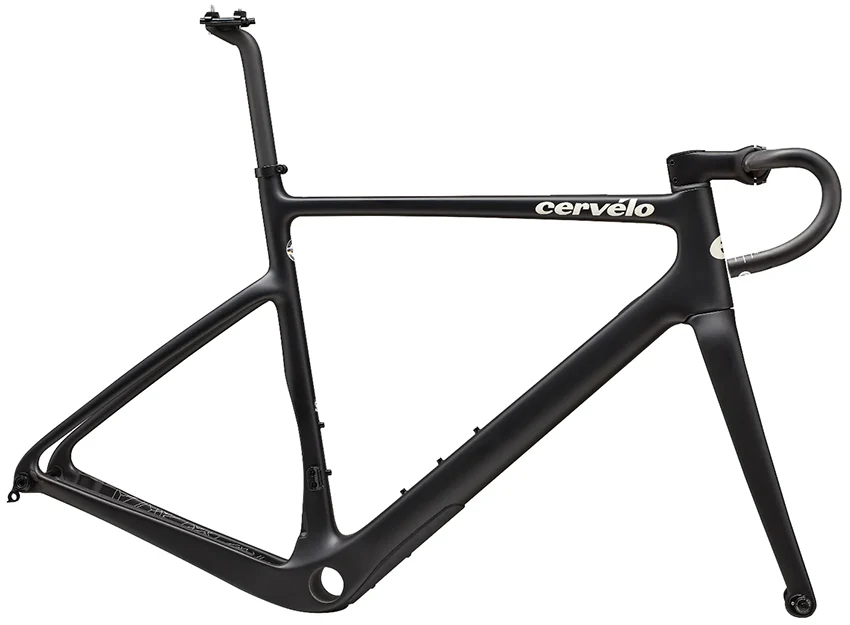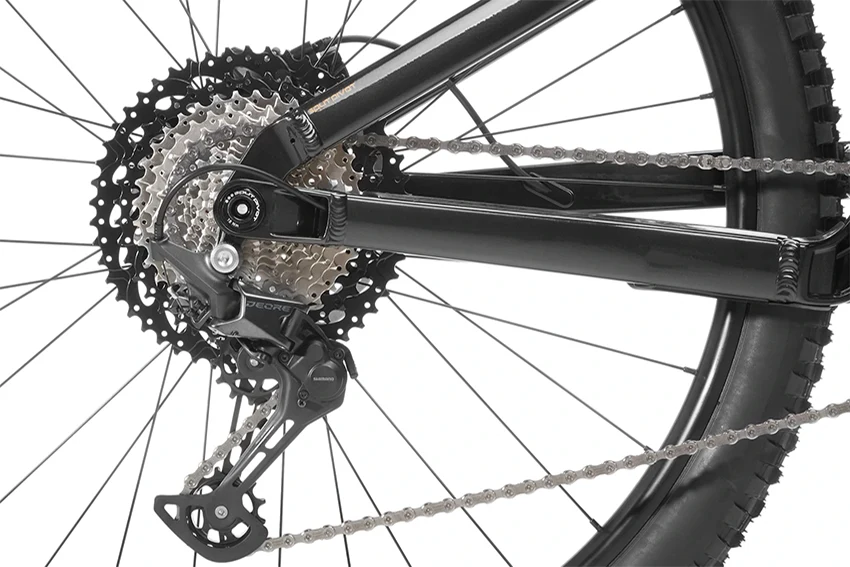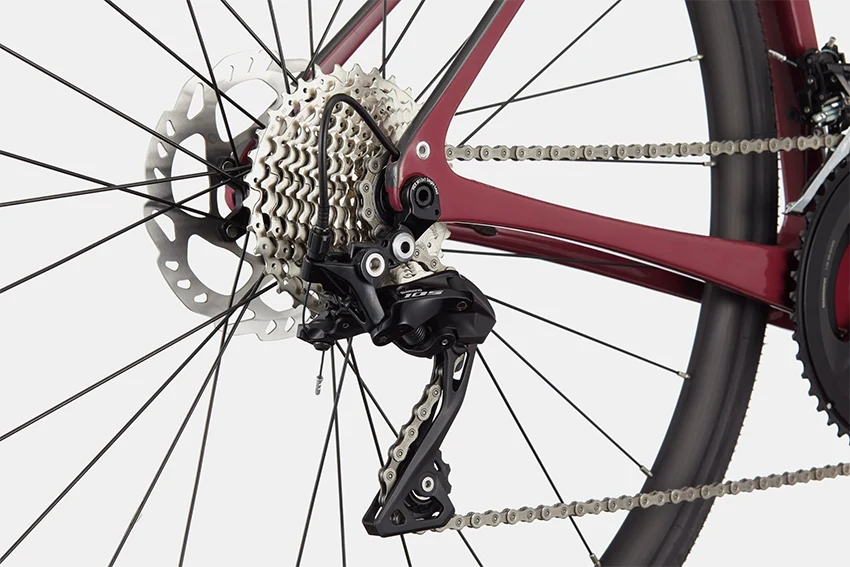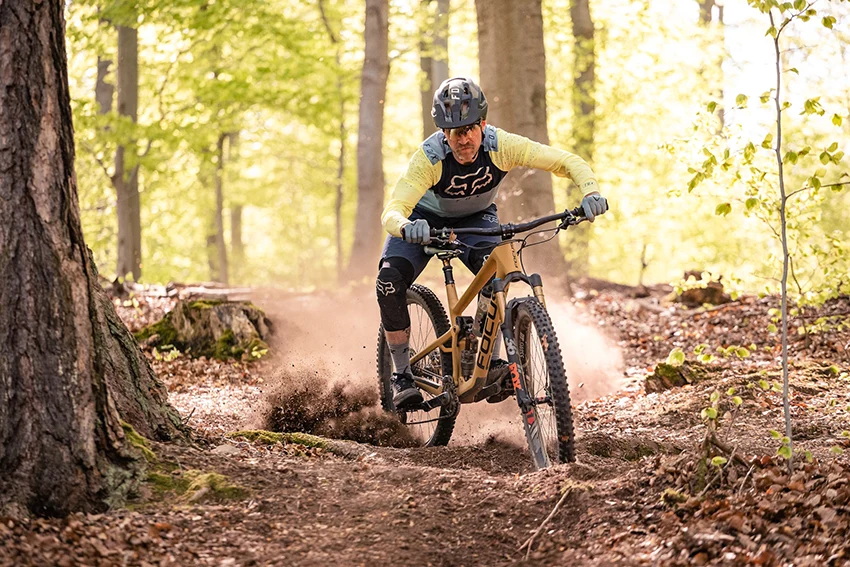Road Bikes vs. Mountain Bikes: Understanding the Differences and Similarities
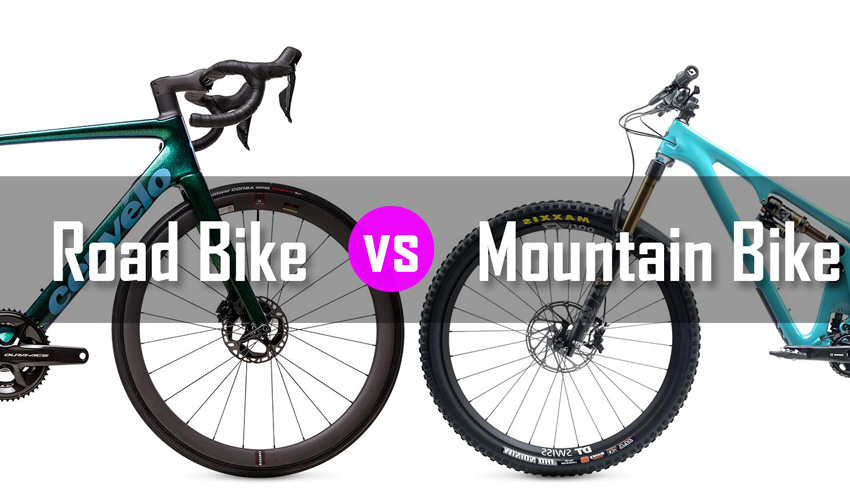
Road bikes and mountain bikes are the two most common types of bicycles available, serving the two most common riding disciplines – road racing and off-road riding.
If you enjoy going as fast as possible on paved roads, a road bike is the right choice for you. However, if you prefer exploring nature and tackling rough terrain, you’ll be better off with a mountain bike.
But what exactly are the main differences between road bikes and mountain bikes and do the two have any similarities?
We’ll explain everything in our guide below and help you decide which one to get!
Use Cases of Road Bikes and Mountain Bikes
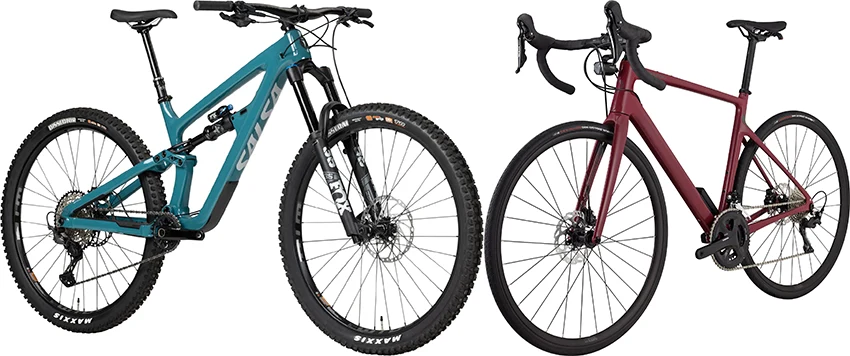
Road bikes and mountain bikes are diametrically different, each designed for specific riding surfaces and terrains.
While many other popular types of bikes can be used for different purposes, road bikes and mountain bikes are specialized for certain types of riding.
Road bikes are optimized for speed and efficiency on smooth tarmac roads and are characterized by having thin tires, lightweight frames, and an aerodynamic riding position. They are perfect for racing, long-distance riding, and speedy urban commutes. If you’re looking to cover long distances with minimal effort, a road bike is likely the right choice.
Road bikes excel in speed and efficiency on smooth roads, while mountain bikes are built for rough terrain, each offering specialized features for their intended environment.
On the other hand, mountain bikes are designed for tackling rough terrains, such as dirt trails, fire roads, and rock gardens. They come equipped with wide knobbly tires with an aggressive tread pattern, sturdy frames with front and/or rear suspension, and powerful disc brakes. In short, if your ideal day on the bike involves exploring forest trails and seeking adventure off the beaten path, a mountain bike will be the right choice.
If you’re on the fence between the two, the best gravel bikes can typically do both of these things good enough. They have road-style frames and drop bars along with wider tires and a more upright position.
Road Bike vs. Mountain Bike: Top Features Compared
Frames
Click the arrow to reveal the images.
The frame is a crucial aspect that differentiates road bikes from mountain bikes.
Road bike frames are engineered for speed and efficiency, prioritizing low weight and aerodynamics. They are typically built from lightweight materials, usually aluminum on cheap road bikes and carbon fiber on the best road bikes, and in very rare cases, steel or titanium. The design is sleek with thin tubes that reduce drag and improve aerodynamic efficiency.
In contrast, modern mountain bikes prioritize durability, comfort, and off-road handling and maneuverability. The best mountain bikes are usually made from high-quality carbon fiber, while cheap mountain bikes use high-grade lightweight aluminum or even steel.
Mountain bike frames are usually heavier and bulkier, with thicker tubing that’s capable of withstanding impacts from roots, rocks, and other obstacles. Mountain bike frames also often incorporate front and/or rear suspension that adds weight but improves off-road handling and performance.
Handlebars
Click the arrow to reveal the images.
Road bikes almost exclusively use drop bars, which are designed to offer multiple hand positions and improve aerodynamics. These are very important features, especially on long rides, as multiple hand positions help alleviate hand and arm pain.
Road bike handlebars also allow road cyclists to drop into a more aerodynamic position on descents and flats, get onto the ‘tops’ to be more upright while climbing, or stay on the ‘hoods’ to balance comfort and aerodynamics.
Finally, drop bars are a lot narrower than flat bars on mountain bikes, which is beneficial for aerodynamics, but not when it comes to stability on off-road terrain.
Related guide: Bike Handlebar Types Explained
On the other hand, mountain bikes have flat, wide handlebars that provide a lot more stability and control while riding on rough terrain. These handlebars also enable riders to stay in an upright riding position, improving visibility of the trail ahead and maneuverability on technical sections.
Unlike drop bars, flat mountain bike handlebars allow for one hand position only, which provides the most leverage on trails, but can cause hand and arm aches on long rides.
Wheels and Tires
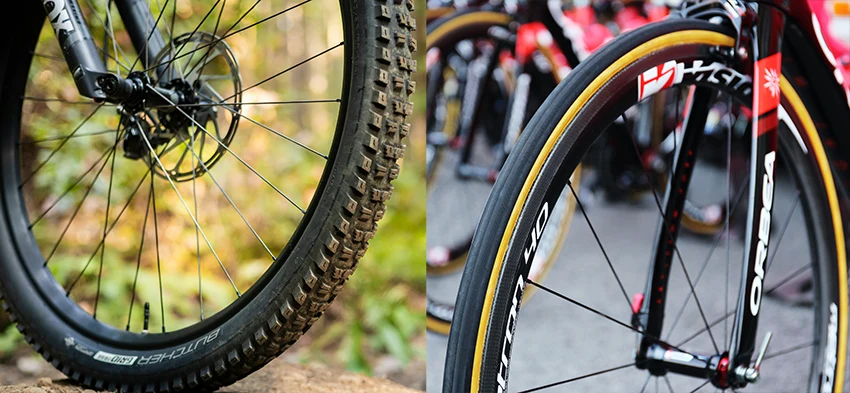
One of the biggest differences between road bikes and mountain bikes has to do with wheels and the width of tires.
Since road bikes are optimized for speed and efficiency on smooth paved roads, they typically come with lightweight 700C wheels and narrow tires, usually around 23-28mm in width. These tires are inflated to high pressures (100+ PSI) which minimizes rolling resistance and maximizes speed and power efficiency. A lot of high-end road bikes come with deep section carbon rims that improve aerodynamics further.
Related: Bike Wheel Size Guide
Mountain bike wheels and tires are completely different from those found on road bikes. The two most common wheel diameters nowadays are 27.5″ and 29″ wheels, each with its own set of advantages and disadvantages. These typically come with tires that are at least 2 inches wide, with thick knobs that improve grip and traction on chunky terrain. Due to their width, these tires can also be run at lower pressures which helps them absorb shocks and provide more grip in wet and slippery riding conditions.
In the past, 26-inch bike wheels were also common on mountain bikes, but nowadays they are mostly found on fat-tire bikes and kids’ bikes.
Drivetrain and Gearing
Click the arrow to reveal the images.
The gearing systems on road vs. mountain bikes prioritize different ride characteristics.
Road bikes have drivetrains and components that are optimized for speed and maximum efficiency on paved surfaces and long rides with high gear ratios. Modern road bikes typically come with two front chainrings and a 9-12-cog rear cassette, depending on the quality of the bike groupsets. High-end road groupsets come with 12 gears on the rear, which helps with maintaining an efficient and consistent pedaling cadence. The derailleurs and shifters are also made from lightweight materials and are designed to be sleek and streamlined.
Road bikes feature high gear ratios for speed and efficiency on paved roads, while mountain bikes have robust, lower gear ratios for tackling steep, off-road terrains.
Mountain bikes usually come with a wider range of gears and fewer gears in total, which lowers complexity and boosts overall durability. Modern mountain bikes typically come with one front chainring and an 11 or 12-speed rear derailleur, with much lower gear ratios than road bikes. This allows mountain bicycles to tackle off-road terrains, especially steep technical climbs. The gear systems are not as lightweight as on road bikes, but they are more robust and durable, so they can withstand more abuse and handle debris, mud, and trail impacts better.
Brakes
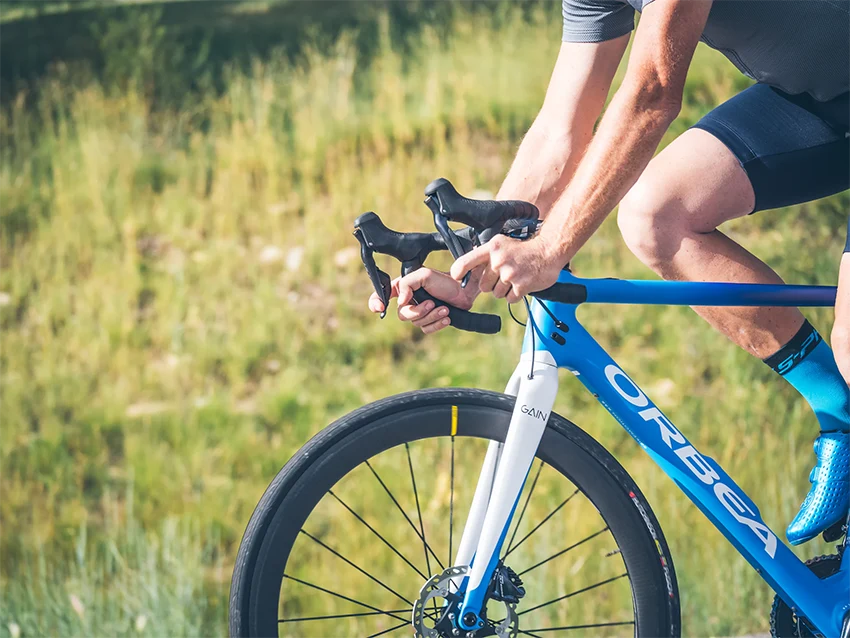
Nowadays, disc brakes have become the golden standard in most cycling disciplines, including road biking and mountain biking. Though, in the past, road bikes typically came with caliper rim brakes in order to lower the weight.
Even though the braking technology today is pretty much the same on these two types of bikes, there are still some slight variations that can make a big difference in the real world.
Road bikes mostly come with 2-piston hydraulic disc brakes and rotors ranging between 140-160mm in diameter. They provide sufficient control and braking power on smooth tarmac roads.
On the other hand, mountain bikes often come with 2-piston or 4-piston hydraulic disc brakes and rotors that range between 180-200+ mm in diameter. These setups provide much more braking power and control, which is necessary on rough trails and descents where the margins for error are much lower. The brake levers are easy to press and allow you to gauge how much braking power you’re applying.
Lower-end bikes in both categories may also come with slightly inferior mechanical disc brakes, whereas some road bikes still have caliper brakes, as there’s still a strong rider fan base for these. Read more about it in our detailed guide on different types of bike brakes.
Frame Geometry
Click the arrow to reveal the images.
The geometry of a road bike favors speed and nimble handling, featuring a short wheelbase, steep head and seat angles, and a longer reach that puts the rider in an aggressive position. This setup allows riders to be in an aerodynamic posture and improves handling responsiveness at high speeds, especially when taking tight corners.
Modern mountain bike’s frame geometry features a longer wheelbase and a slacker head angle, which makes the bike more stable over rough obstacles and during fast descents. The reach is not as long as on road bikes, which allows the rider to assume a more comfortable upright riding position, improving the visibility of the trail ahead and reducing fatigue. They also have a lower center of gravity that further improves stability.
Therefore, the two bikes have completely different frame geometries that prioritize diametrically different ride characteristics.
Suspension
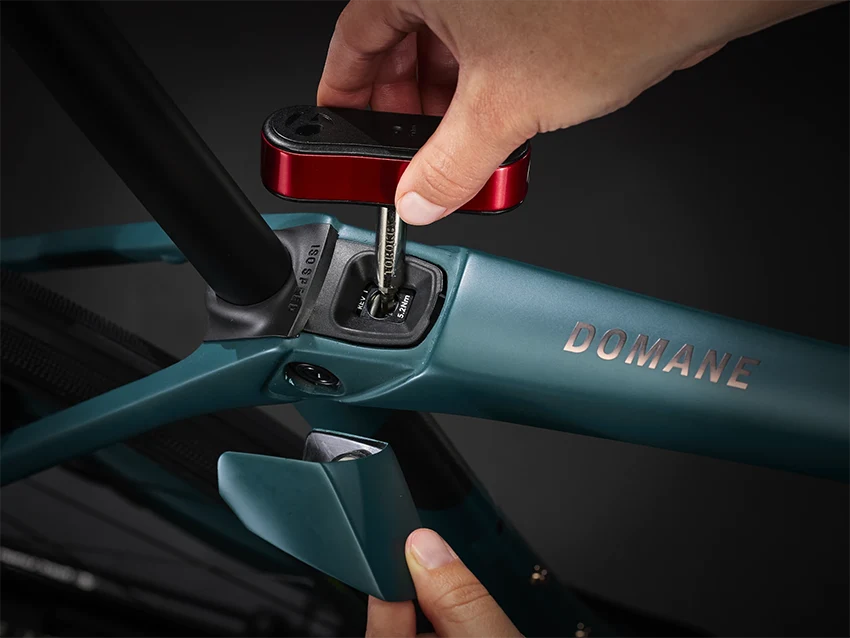
Trek Bikes’ adjustable IsoSpeed road bike suspension.
Suspension is one of the areas where road bikes and mountain bikes differ the most.
Since road bikes are designed for smooth paved roads, they do not need heavy and complex suspension systems. That said, some high-end performance bikes, gravel bikes, or endurance road bikes come with short-travel suspension systems to reduce rider fatigue and improve comfort on long rides. A few notable examples include Trek’s IsoSpeed and Specialized Future Shock systems.
Road bikes typically lack suspension due to their use on smooth roads, while mountain bikes require suspension to enhance comfort, control, and traction on rough terrains.
On the other hand, front and/or rear suspension is a must on all high-performance mountain bikes. Hardtail mountain bikes have front fork suspension only, whereas full-suspension mountain bikes have front and rear suspension. MTBs without any suspension are called ‘rigid mountain bikes,’ but they are not as common as the two base types.
The amount of mountain bike suspension (travel) is measured in millimeters and determines the intended use of the bike, such as cross-country, trail, enduro, dirt, or downhill. The suspension not only improves comfort, but is also crucial for improving control, handling, and traction on technical sections of the trails.
Pros and Cons of Road Bike vs. Mountain Bike
Now that we know all the differences and similarities between road and mountain bikes, let’s see what are the main strengths and weaknesses of each type.
Pros and Cons of Road Bikes
- Road bikes are fast, efficient, and light
- Aerodynamic design improves long-distance efficiency
- Drop bars allow for multiple hand positions lowering fatigue
- Easier to maintain due to fewer moving parts
- Suitable for different uses, such as fitness and commuting
- Can only be ridden on relatively smooth terrain
- Narrow tires lose traction easily
- You often need to ride in heavy traffic
Pros and Cons of Mountain Bikes
- Can be ridden on a wide range of terrains and surfaces
- Built with durable materials that withstand abuse
- Wide tires and suspension offer lots of comfort and control
- Plenty of traction and stability in wet and slippery conditions
- Typically ridden in remote areas, away from the dangers of traffic
- Heavy and complex design
- Slow and inefficient on paved roads
- Costly maintenance due to more moving parts
Road Bikes vs. Mountain Bikes: How to Decide?
To sum up, both road bikes and mountain bikes have specific advantages and disadvantages you need to consider before deciding which one to buy.
However, choosing between the two should not be a problem if you know what style of riding you want to do, as the differences are pretty clear-cut.
Road bikes excel in speed, pedaling efficiency, and long-distance riding on smooth roads, which makes them ideal for racing, fitness, and commuting.
Choosing between road and mountain bikes depends on your riding style; road bikes are for speed and efficiency on tarmac, while mountain bikes are for off-road conditions, with hybrids offering a blend of both.
On the other hand, mountain bikes shine in off-road conditions, where features like wide tires, suspension forks, low-gear ratios, and powerful brakes make all the difference.
Ultimately, the choice boils down to your cycling preferences, though a lot of riders choose to own both types and use them for different kinds of riding. If you can’t decide, you should consider the best hybrid bikes, as they blend the best features of both types.

